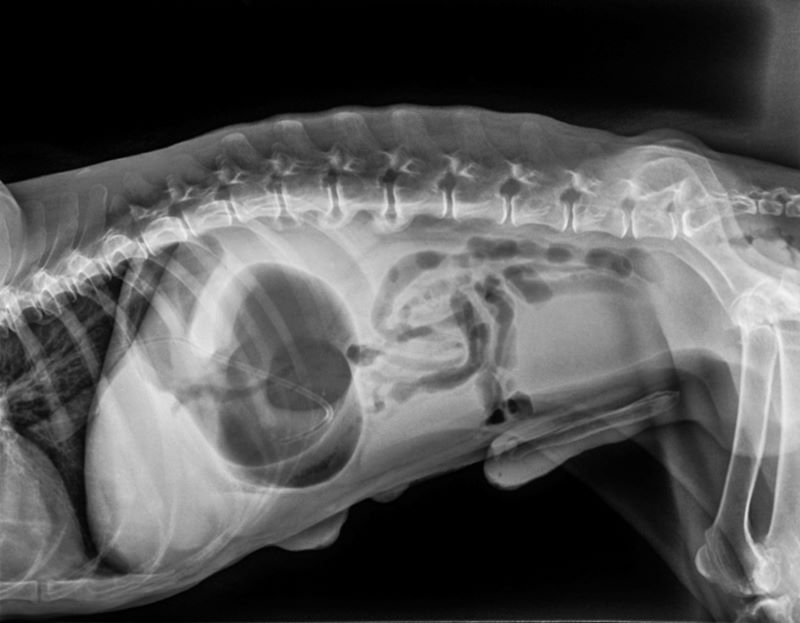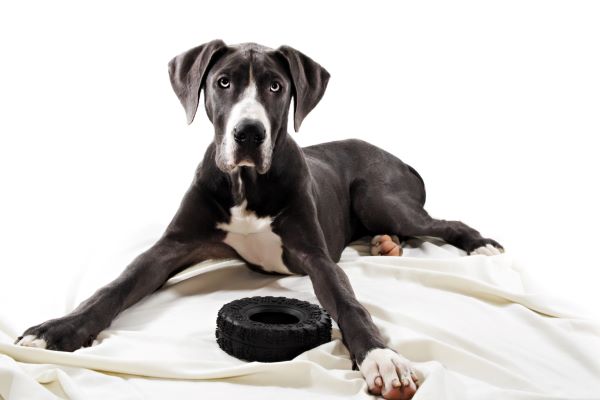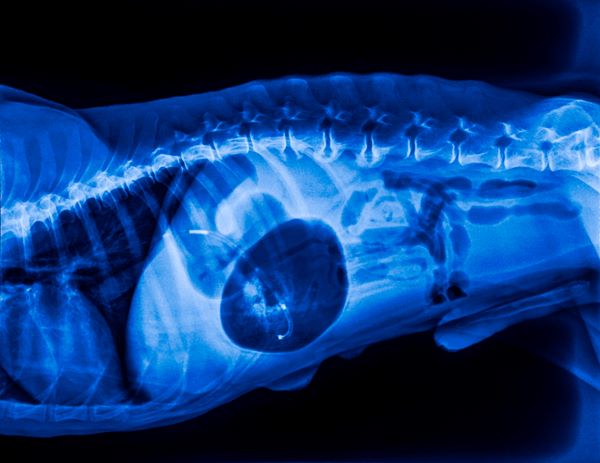
Gastric Dilatation-Volvulus, commonly known as GDV or bloat, is a severe medical condition in dogs that can affect dogs and becomes life-threatening very quickly. Recognizing the signs early and immediately getting your dog to veterinary care can save their life.
What is GDV in Dogs?
GDV occurs when a dog’s stomach fills up with gas, fluid, or food, causing it to bloat. In some cases, the stomach twists, trapping the contents inside. This twist also blocks blood flow to the stomach and other organs, leading to severe internal damage. If not treated right away, GDV can cause serious health issues and is often fatal.
What Causes Gastric Dilatation-Volvulus in Dogs?
While the exact cause of GDV isn’t fully known, several factors can increase a dog’s risk:
- Breed: Large dogs with deep chests, like Great Danes or German Shepherds, are more likely to develop GDV. Dogs whose lineage has a history of GDV are at a higher risk.
- Eating Habits: Dogs that eat large amounts at once or only have one meal daily are at a higher risk.
- Stress: High levels of stress or anxiety may contribute to the development of GDV due to panting and increased activity.
- Age: Older dogs are more prone to GDV than younger ones.
Awareness of these risk factors and watching your dog’s behavior around meals can help reduce their risk of developing this dangerous condition. However, the only preventative measure is prophylactic surgery.

Breeds at Higher Risk of Gastric Dilatation-Volvulus
While GDV can occur in any dog, certain breeds are more prone to this condition due to their physical characteristics. Breeds at higher risk include:
- Great Danes
- German Shepherds
- Standard Poodles
- Saint Bernards
- Weimaraners
- Boxers
- Setters
- Doodles
- Labrador Retrievers
- Any dog greater than 70 lbs when fully grown
These breeds have deep, narrow chests, which makes them more vulnerable to their stomach twisting. It’s a good idea to watch dogs from these breeds closely, especially as they age, for signs of GDV.
Symptoms of GDV
Recognizing the signs of GDV early can save your dog’s life. Symptoms can appear suddenly and may include:
- Abdominal Bloating: A swollen or distended belly.
- Unproductive Retching: Trying to vomit but nothing comes out.
- Excessive Drooling: Lots of saliva, usually because the dog feels nauseous.
- Restlessness: Pacing or acting like they can’t get comfortable.
- Rapid Heartbeat: Your dog’s heart may beat faster as their body struggles.
- Weakness or Collapse: In severe cases, your dog may become weak or even collapse.
If you notice any of these signs, get your dog veterinary care immediately. Quick action is crucial in treating GDV.
What to Do If You Notice Signs of GDV
- Stay Calm: Try to stay calm to prevent further stressing your dog.
- Do Not Attempt Home Treatment: GDV is a medical emergency that cannot be treated at home.
- Immediate Veterinary Attention: Quickly transport your dog to the nearest emergency veterinary clinic.
- Call Ahead: If possible, call the clinic on the way to alert them of the situation so they can prepare for your arrival.
- Avoid Feeding or Giving Water: Do not attempt to feed or give water to your dog while waiting to reach the vet, as this can exacerbate the condition.
- Comfort Your Dog: Keep your dog comfortable and minimize movement during transportation.
How GDV Is Diagnosed?
A veterinarian will diagnose GDV by doing a physical exam and taking X-rays. The exam may reveal a bloated belly, and the vet might see signs of shock. X-rays will confirm if the stomach is twisted and filled with gas. Blood tests might also be done to determine how severe the condition is and to guide treatment.

Treatment of GDV
GDV is a medical emergency that requires swift intervention. Treatment for GDV involves stabilizing the dog and if the stomach has twisted, surgical correction. The primary steps include:
- Stabilization: Initial steps involve stabilizing the dog with intravenous fluids and oxygen therapy.
- Decompression: The vet will release the trapped gas through a stomach tube or needle.
- Surgery: Surgery is necessary to untwist the stomach and check for damage. The vet will also perform a gastropexy, which involves attaching the stomach to the abdominal wall to prevent future twisting.
- Post-Operative Care: After surgery, your dog will need close monitoring, pain management, and proper nutrition to help them recover.
Prompt treatment is critical to increase the chances of a successful outcome. Delays in treatment can significantly decrease a dog’s survival rate.
Laparoscopic Gastropexy: Preventive Surgery
Laparoscopic gastropexy is a minimally invasive surgery that’s becoming more common for preventing GDV. It involves making small cuts and using a camera to help guide the procedure.
Benefits of Laparoscopic Gastropexy:
- Less Pain: Smaller incisions mean less discomfort for your dog after surgery.
- Faster Recovery: Dogs usually heal faster compared to traditional surgery.
- Lower Risk of Infection: Smaller wounds mean less chance of infection.
- Less Scarring: The cosmetic result is better with less noticeable scars.
This surgery is often recommended for high-risk breeds and can also be done during their spay or neuter.
Procedure and Recovery
During laparoscopic gastropexy, your dog will be under general anesthesia. Small incisions are made, and the stomach is attached to the abdominal wall using sutures. The surgery usually takes about 60 to 90 minutes.
After surgery, your dog will need to be watched closely for complications like infection. Most dogs return to their normal activities within a few weeks, but following your vet’s aftercare instructions is crucial for a smooth recovery.
Preventing GDV
While not all cases of GDV can be prevented, certain measures can reduce the risk:
Gastropexy: In high-risk breeds, preventive surgery (gastropexy) can be performed to attach the stomach to the abdominal wall, preventing twisting. This is the only measure which can prevent GDV.
Feed smaller, frequent meals: Avoid large meals and ensure your dog eats slowly.
Reduce stress: Maintain a calm environment and avoid sudden changes in routine.
By implementing these preventive measures, dog owners can help reduce the risk of GDV and protect their pets from this dangerous condition.
GDV FAQs
What are the first signs of GDV in dogs? The first signs of GDV often include a distended abdomen, unproductive retching, and excessive drooling. Dogs may also appear restless or agitated.
How fast does GDV progress in dogs? GDV can progress rapidly, sometimes within hours. Immediate veterinary intervention is crucial to prevent severe complications and increase survival chances.
Can GDV be treated without surgery? While initial treatment involves stabilizing the dog, if the stomach is twisted, surgery is necessary to correct it and prevent recurrence. While GDV can occur without the stomach twisting, your veterinarian will most likely recommend Gastropexy as a preventive, life-saving measure.
Is GDV hereditary in dogs? There is a genetic component to GDV, particularly in breeds with a predisposed anatomical structure. Breeding practices should consider this risk to reduce GDV incidence.
What is gastropexy, and how does it prevent GDV? A gastropexy is a surgical procedure that attaches the stomach to the abdominal wall, preventing it from twisting. It is often performed prophylactically in high-risk breeds to reduce the risk of GDV.
Understanding GDV and taking proactive steps can save your dog’s life. Be vigilant about the signs and seek immediate veterinary attention if you suspect GDV. Prevention, though not a guarantee, can significantly reduce the risks and can ensure your furry friend stays healthy and happy.

